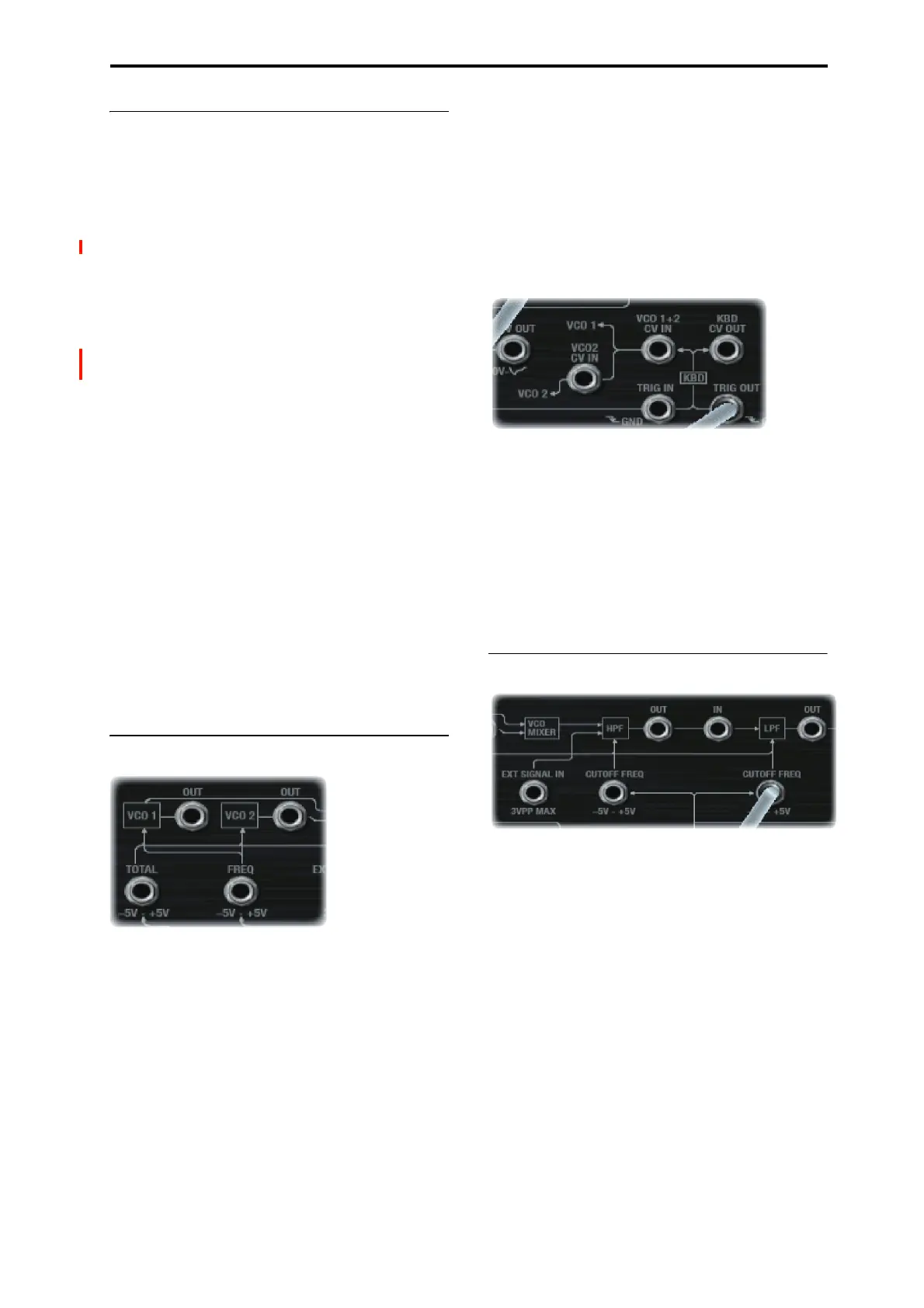PROGRAM > MS-20EX: Patch Panel 6–1: Patch Panel
269
Tip: Creating self-triggering patches
Normally, new notes and EGs 1 and 2 are triggered by
playing notes on the keyboard. They don’t have to be,
however. You can use the MG Square/Pulse output, the Trig
Out of the External Signal Processor, or AMS signals from
the Wheel or Switch jacks to trigger one or both EGs.
Note: EGs 1 and 2 trigger when the input is at 0 (“low”),
such as when the MG Square/Pulse is in the bottom portion
of the waveform. The MG’s indicator LED is on during this
portion of the waveform.
You can also use AMS (such as LFOs) to reset EGs 3-6, if
desired. Finally, the Common Step Sequencer and LFO can
also be reset via a selection of controllers, including the X-Y
Envelope CCs.
Even when a patch is self-triggering, it will only play when a
note is played on the keyboard, held by the damper pedal, or
held via the Program Basic page’s Hold parameter. When
the note is released (by lifting up on the keyboard or damper
pedal, or turning off Hold), the EG selected by the VOICE
ALLOCATION parameter will automatically enter its
release phase, and will no longer re-trigger. All other EGs
will continue to re-trigger, according to the Patch Panel and
AMS settings.
In some cases, you may want some elements of the patch to
re-trigger automatically, while others are still triggered from
the keyboard. To allow the keyboard to act as a trigger while
you are holding the sustain pedal (or while Hold is enabled):
1. Select the KBD TRIG OUT jack.
2. In the Parameter Details box, set Trigger On to Note
Gate.
For more information, see “KBD TRIG OUT jack” on
page 275.
6–1a: VCOs 1 and 2
For descriptions of the VCO parameters, see “4–1a:
Oscillators” on page 259.
(VCO 1) OUT jack
This Patch Panel modification provides the output of VCO 1.
(VCO 2) OUT jack
This Patch Panel modification provides the output of VCO 2.
TOTAL input jack
This input modulates the frequencies of VCOs 1 and 2, the
HPF, and the LPF. It’s normalled to the MG
sawtooth/triangle output, but you can use patch cables to
connect any other modulation source.
Each of the destinations has a knob to scale the amount of
modulation from the TOTAL input. For more information,
see:
• VCO 1 and 2 pitch: “MG/T.EXT” on page 260
• HPF frequency: “MG/T.EXT” on page 261
• LPF frequency:“MG/T.EXT” on page 261
FREQ input jack
This input modulates the frequencies of VCOs 1 and 2. The
signal is scaled by the EG1/EXT knob, as described under
“EG1/EXT” on page 260.
VCO CV (Control Voltage) inputs
VCO 1+2 CV IN jack
This controls the basic pitch of both VCO1 and VCO2.
Normally, this signal comes from the notes played on the
keyboard (or via MIDI). You can patch other signals into this
jack to create special effects, or to follow the pitch of an
external audio input.
VCO 2 CV IN jack
This is similar to “VCO 1+2 CV IN jack,” above, but affects
VCO 2 only.
6–1b: HPF and LPF
EXT SIGNAL IN jack
This is a direct input to the HPF, summed with the output of
the VCO Mixer.
(HPF) CUTOFF FREQ input jack
This input modulates the cutoff frequency of the Highpass
Filter.
(HPF) OUT jack
This Patch Panel modification provides the output of the
Highpass Filter.
(LPF) CUTOFF FREQ input jack
This input modulates the cutoff frequency of the Lowpass
Filter.
(LPF) IN jack
This Patch Panel modification provides a direct input to the
Lowpass Filter.
(LPF) OUT jack
This Patch Panel modification provides the output of the
Lowpass Filter.

